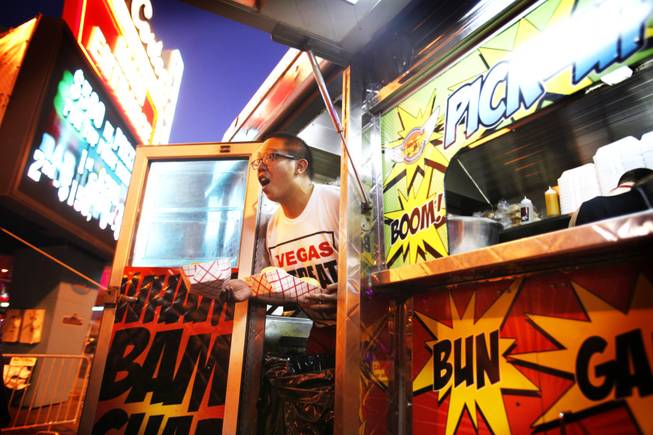
Luis Mora calls out an order at the Slidin’ Thru truck during Vegas Streats in downtown Las Vegas on Saturday, Oct. 8, 2011.
Tuesday, Jan. 22, 2013 | 2:27 p.m.
Three months after restricting where food trucks can do business, the Las Vegas City Council will consider a new proposal giving the mobile vendors more room downtown to operate legally.
Under the proposed ordinance, three new food truck-only parking spaces, which can be leased for $5 per hour, would be created downtown.
During a recommending committee meeting Tuesday morning, Brandy Stanley, the city’s parking services manager, described the new bill as a counterpart to a measure passed in October that prohibited food trucks from selling food within 150 feet of a brick-and-mortar restaurant.
Food trucks offering their takes on everything from cheeseburgers to pizza to barbecue have proliferated downtown in recent years. But outside of planned, permitted events, finding space to operate the trucks legally downtown is a challenge.
In addition to the restaurant buffer, trucks are allowed to park at city parking meters for only half an hour at a time, even though it often takes them that much time to set up for the lunch rush, Stanley said.
The changes introduced Tuesday, which likely will be voted on by the full council at its Feb. 6 meeting, would create food truck-specific parking spaces near the Regional Justice Center, Bonneville Transit Center and Las Vegas City Hall as part of a pilot program. The Fremont East district, a popular roaming spot for food trucks, will not have one of the spaces after the district’s board asked to be left out of the program, Stanley said.
Each space would be converted from two existing parking spaces, Stanley said, and could only be used for food trucks.
Trucks could apply to use any of the spaces through a lottery system operated by the city’s business licensing department.
“ (We) have been working to set up a reservation calendar that could eventually be open to the public so they could see when and where and who will be in each one of these locations during various times of the day,” Stanley said.
After six months, the program would be evaluated and any needed changes made, including possibly adding more parking locations, Stanley said.
“Working in conjunction with the business community and the mobile food vendors, we want to try it out for six months, see how it works and make any tweaks to the programs,” she said.

Join the Discussion:
Check this out for a full explanation of our conversion to the LiveFyre commenting system and instructions on how to sign up for an account.
Full comments policy